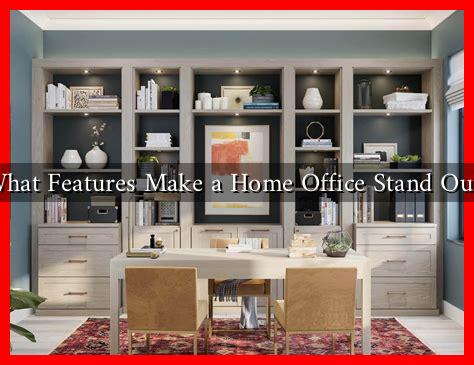-
Table of Contents
What Features Make a Home Office Stand Out?
As remote work becomes increasingly prevalent, the importance of a well-designed home office cannot be overstated. A standout home office not only enhances productivity but also contributes to overall well-being. In this article, we will explore the key features that make a home office exceptional, providing insights and examples to help you create your ideal workspace.
1. Ergonomic Furniture
One of the most critical aspects of a home office is the furniture. Ergonomic furniture is designed to support the body and promote good posture, which is essential for long hours of work. Here are some key elements:
- Adjustable Desk: A sit-stand desk allows you to alternate between sitting and standing, reducing the risk of back pain.
- Ergonomic Chair: A chair with lumbar support and adjustable features can significantly improve comfort.
- Monitor Stands: Elevating your monitor to eye level can help prevent neck strain.
According to a study by the Occupational Safety and Health Administration (OSHA), ergonomic workstations can reduce the risk of musculoskeletal disorders by up to 50%. Investing in quality ergonomic furniture is not just a luxury; it’s a necessity for a productive home office.
2. Adequate Lighting
Lighting plays a crucial role in creating an inviting and functional workspace. Poor lighting can lead to eye strain and fatigue, while good lighting can enhance mood and productivity. Consider the following:
- Natural Light: Position your desk near a window to take advantage of natural light, which has been shown to improve mood and energy levels.
- Task Lighting: Use desk lamps with adjustable brightness to focus light on specific areas without causing glare.
- Ambient Lighting: Soft overhead lighting can create a warm atmosphere, making the space more inviting.
A study by the American Society of Interior Designers found that 68% of employees believe that lighting affects their productivity. Therefore, investing in proper lighting is essential for a standout home office.
3. Personalization and Aesthetics
A home office should reflect your personality and style. Personalization can enhance your connection to the space, making it more enjoyable to work in. Here are some ideas:
- Artwork: Hang inspiring artwork or photographs that motivate you.
- Color Scheme: Choose colors that promote focus and creativity, such as blues and greens.
- Plants: Incorporate greenery to improve air quality and add a touch of nature.
According to a study published in the Journal of Environmental Psychology, incorporating plants into your workspace can increase productivity by up to 15%. Personalizing your home office not only makes it visually appealing but also enhances your overall work experience.
4. Technology Integration
In today’s digital age, a standout home office must be equipped with the right technology. Efficient tech integration can streamline your workflow and enhance productivity. Consider the following:
- High-Speed Internet: A reliable internet connection is essential for video calls and online collaboration.
- Smart Devices: Use smart speakers or assistants to manage tasks and set reminders.
- Quality Equipment: Invest in a good webcam, microphone, and noise-canceling headphones for clear communication.
According to a report by Buffer, 20% of remote workers cite technology issues as a significant challenge. Ensuring that your home office is equipped with the latest technology can help mitigate these challenges.
5. Organization and Storage Solutions
A cluttered workspace can lead to distractions and decreased productivity. Effective organization is key to maintaining focus. Here are some tips:
- Storage Solutions: Use shelves, filing cabinets, and organizers to keep your workspace tidy.
- Declutter Regularly: Set aside time each week to remove unnecessary items from your desk.
- Digital Organization: Utilize cloud storage and project management tools to keep digital files organized.
Research from the Princeton University Neuroscience Institute indicates that clutter can negatively impact your ability to focus. A well-organized home office can help you maintain clarity and efficiency.
Conclusion
Creating a standout home office involves a combination of ergonomic furniture, adequate lighting, personalization, technology integration, and effective organization. By investing in these features, you can enhance your productivity and overall work experience. As remote work continues to evolve, a well-designed home office will not only serve as a functional workspace but also as a sanctuary that inspires creativity and focus. For more tips on home office design, check out resources from the American Society of Interior Designers.

